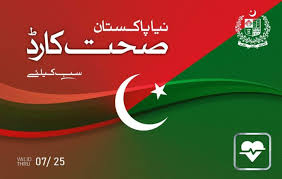No one can deny that national healthcare is desperately needed in Pakistan. This sector has been ignored since decades resulting in severe hardship for our low-income groups (which means by far the great majority of people in our country). Most of our public hospitals were built a long time ago, some of them, like Mayo Hospital, Lady Wellington etc, were built before partition. The vacuum created by the governments neglect of the health sector has been filled to a great extent by private hospitals. However, the common person is unable to afford treatment in private hospitals.
While the recent announcement of a Health Card for all eligible families is a welcome relief, one wonders if the Health Card is really the best solution.
The health card scheme provides medical insurance to each family up to Rs. 1 million per family per annum. The medical insurance is provided by the State Life Insurance company to which the government will pay an insurance premium of Rs.2820 per family per annum. This health card has been in use for some time in KP province and is now being extended to the other provinces. The experience of the health card in KP province can be used to build a fairly accurate model for the whole country.
In KP province the government paid an insurance premium of Rs.2820 per family per annum for 7.5 million families at a total annual cost of Rs.23 billion. It was assumed that each family consists on average of 4.7 persons, which means the insurance cost was Rs.600 per person. Based on current population statistics the total cost for the whole country will be Rs.134 Billion per annum.
Experience of the health card in KP province has shown that 70% of the people who received the health card, used it in private hospitals to get medical treatment, and only 30% used the health card in government hospitals.
The current construction cost of building a hospital in Pakistan is Rs.1.5 million per bed. Generally, a full-sized hospital has 600 beds so a midsize hospital can be considered to have 300 beds. This means the construction cost of a 300-bed hospital is Rs.450 million. A liberal estimate of equipment, fixtures, fittings etc is another Rs.450 million. Therefore a 300 bed fully operational hospital would cost not more than Rs. 900 million. This means that in the government’s health insurance budget of just one year, 150 new fully operational public hospitals could be built.
Imagine the kind of economic boost the country would get if the government started a mega project of building 150 new hospitals across the country simultaneously. The amount of cement, bricks, steel, paint etc that would be used, not to mention the number of jobs that would be created. Further, on an expenditure of Rs.134 billion the government would collect around Rs.20 billion in taxes, thereby reducing the net cost of the scheme to Rs.114 billion. This would be the utilisation of one year’s health card cost. Subsequent years health card budget of Rs.134 billion per annum could be used to cover the operational running costs of the 150 hospitals (equivalent to Rs.70 million per month per hospital). This would create many permanent jobs for doctors, nurses, cleaners etc and would generate another Rs. 25 billion per annum in taxes.
In the alternative health care scheme outlined above the 150 government owned hospitals would provide free medical treatment to the general public, creating jobs and generating tax revenue. Experience of the health card in KP province has shown that 70% of the people who received the health card, used it in private hospitals to get medical treatment, and only 30% used the health card in government hospitals.
While this may be understandable because there aren’t enough public hospitals, it is a pity that government money (public funds) are being used to enrich owners of private hospitals who are already multi billionaires. Using the KP experience as the basis one can say that, in the current health card scheme, around Rs.90 billion (70% of Rs.134 billion) of public money will find its way into the already bulging pockets of private hospital owners every year.
Whether State Life Insurance company will be bankrupted by this health card scheme or not, is another story.























